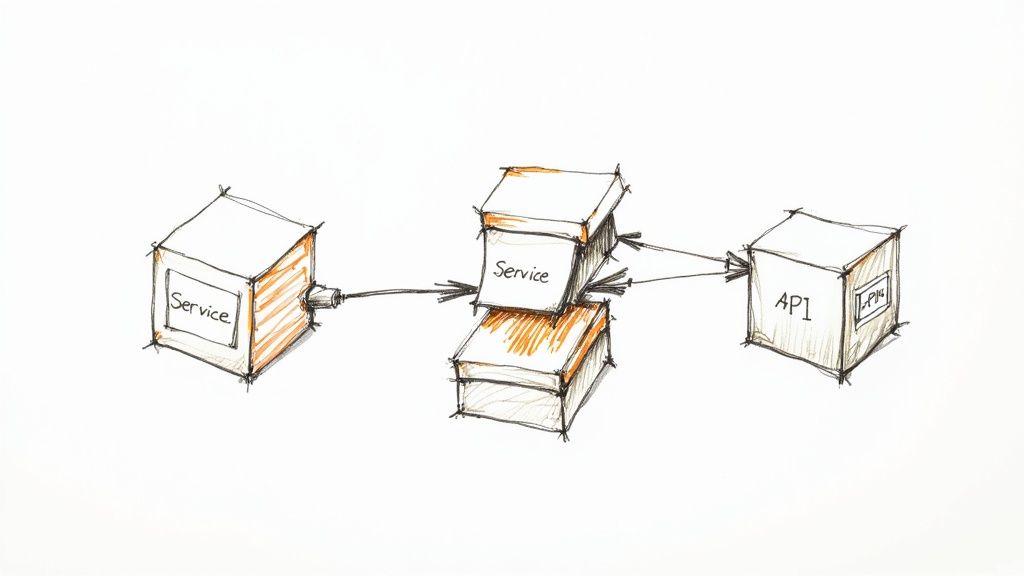Business Innovation Models: Drive Growth & Stay Competitive
Oct 7, 2025 in Guide: Explainer
Explore top business innovation models with real examples. Learn to select and apply frameworks that boost growth and keep you ahead.
Not a member? Sign up now
NILG.AI on Oct 6, 2025
Digital transformation isn’t just about adopting new tech; it’s a fundamental shift in how your entire business operates and delivers value. It’s easy to get lost in the hype, but the real question is: where do you actually begin? Getting it right means more than just a software update. It’s about rethinking processes, empowering teams, and putting customers at the center of everything you do.
This guide is designed to cut through the noise. We’re skipping the vague theories and diving straight into the practical, actionable steps that drive real results. You won’t find comparisons to massive tech corporations here. Instead, our focus is on what works for ambitious businesses, especially in the AI and data consulting space, who need a clear, strategic path forward. We’ve compiled 10 proven digital transformation best practices that provide a roadmap for turning ambitious goals into tangible outcomes.
These strategies are more than just a checklist; they are foundational pillars for building a resilient, agile, and future-ready organization. For a comprehensive guide to implementing successful digital change, explore these Digital Transformation Best Practices: Top Strategies for 2025 to see how these concepts fit into a larger strategic framework. From cultivating a data-driven culture to investing in your team’s digital skills, each point we cover is a critical piece of the puzzle. Let’s get into the practical steps that will define your success in 2025 and beyond.
It’s easy to get lost in the sea of shiny new tech, from AI to IoT, and think that just adopting them is the goal. But one of the most crucial digital transformation best practices is to flip the script entirely. Instead of starting with the technology, start with the person who matters most: your customer. Focusing on the Customer Experience (CX) means every digital initiative is purpose-built to solve a real customer problem or create a more delightful, seamless journey.
This approach grounds your transformation in value creation. When you prioritize enhancing customer satisfaction, engagement, and loyalty, your technology investments are no longer just expensive experiments. They become strategic tools that directly contribute to business growth and a stronger brand reputation.

A CX-first mindset ensures that you’re not just digitizing old, clunky processes. You’re completely reimagining them from the customer’s point of view. This shift prevents you from investing heavily in solutions that look great on paper but fail to move the needle on what customers actually care about.
For AI and data consultancies, this means mapping the client journey from initial inquiry to project delivery and beyond. A digital portal for tracking project milestones or an automated system for delivering insights can transform the client relationship, solving key pain points around communication and transparency. This focus on CX builds trust and encourages repeat business.
Digital transformation isn’t just about upgrading your technology stack; it’s about upgrading your mindset. One of the most impactful digital transformation best practices is to cultivate a data-driven culture, where decisions are guided by insights and evidence rather than gut feelings or hierarchy. This means building the infrastructure to collect and analyze information, but more importantly, empowering your team to use data confidently in their daily roles.
When data becomes the common language across your organization, you stop guessing and start knowing. Every strategic move, from product development to marketing campaigns, is backed by a clear rationale. This shift not only de-risks decision-making but also uncovers hidden opportunities for efficiency, innovation, and growth that were previously invisible.

A data-driven culture replaces subjective debates with objective conversations. It democratizes decision-making, allowing the best ideas, supported by evidence, to rise to the top, regardless of who they came from. This fosters an environment of continuous learning and improvement, where teams are encouraged to experiment, measure results, and iterate quickly.
For data consultancies, this is about practicing what you preach. Using internal data to optimize project bidding, allocate resources effectively, or forecast revenue demonstrates the power of your own services. This internal proof-of-concept not only improves your operations but also serves as a powerful case study for potential clients.
Traditional, slow-moving development cycles just don’t cut it in today’s fast-paced digital world. To keep up, one of the most effective digital transformation best practices is to adopt Agile and DevOps methodologies. This means shifting away from rigid, long-term project plans and embracing an iterative approach that prioritizes speed, collaboration, and continuous improvement.
These frameworks break down large projects into small, manageable sprints, allowing teams to deliver value faster and adapt to changing requirements on the fly. By merging development (Dev) and operations (Ops), DevOps creates a seamless pipeline for building, testing, and releasing software, drastically reducing time-to-market and improving quality. This operational agility is the engine that powers a successful transformation.

Adopting Agile and DevOps isn’t just about shipping code faster; it’s a fundamental cultural shift that fosters innovation and resilience. It aligns IT capabilities directly with business goals, ensuring technology development is always serving a strategic purpose. This approach eliminates the silos that typically cause bottlenecks and miscommunication between teams.
Leading AI and data consultancies use Agile not just for software development but for client project management. Breaking a complex data science project into two-week sprints with clear deliverables allows for regular client feedback, preventing scope creep and ensuring the final model or dashboard perfectly aligns with the client’s evolving needs.
Your digital transformation strategy is only as strong as the people who execute it. Investing in sophisticated technology without upskilling your workforce is like buying a high-performance race car for someone who has never driven before. This is why one of the most essential digital transformation best practices is to focus on both employee digital skills and robust change management.
This dual approach ensures your team not only knows how to use new digital tools but also understands why the changes are happening and feels supported throughout the transition. It transforms potential resistance into active engagement, turning your employees into powerful advocates for the new digital direction.

Focusing on your people addresses the human side of technological change, which is often the biggest hurdle to successful transformation. When employees feel competent and see a clear path for their own growth within the company’s new vision, fear and uncertainty are replaced with confidence and motivation. This creates a culture of continuous learning and adaptability that fuels long-term success.
For a data consulting firm, this means continuous training not only on the latest AI models and cloud platforms but also on new collaboration tools that streamline remote work. Investing in “soft skills” training for consultants on how to better communicate complex data insights to non-technical clients is equally crucial for digital maturity.
It’s tempting to view the cloud as just a place to store data, but that’s like seeing a smartphone as only a device for making calls. A core component of modern digital transformation best practices is adopting a cloud-first architecture. This means prioritizing cloud-based solutions for new projects and strategically migrating existing systems, fundamentally shifting away from clunky, on-premises hardware.
This approach isn’t just about moving servers off-site; it’s about unlocking unprecedented scalability, agility, and cost efficiency. When you build on the cloud, you gain the power to scale resources up or down on demand, accelerate development cycles, and access cutting-edge tools like AI and machine learning without massive upfront investments in infrastructure.
A cloud-first strategy liberates your organization from the limitations of physical hardware. You no longer need to over-provision servers for peak demand or worry about costly maintenance and upgrades. Instead, you can focus your resources on innovation and delivering value to customers, leveraging the robust, secure, and globally distributed infrastructure of cloud providers.
For AI and data consultancies, a cloud-first approach is non-negotiable. It allows them to spin up powerful computing resources to train complex models for a client project and then spin them down when finished, paying only for what they use. This model provides the agility needed to serve multiple clients with varying computational needs without owning a prohibitively expensive data center.
As you digitize operations and gather more data, you’re also creating a bigger target for cyber threats and a greater responsibility to protect sensitive information. One of the most critical digital transformation best practices is to build a fortress around your data assets from day one. Establishing strong data governance and cybersecurity isn’t just an IT task; it’s a foundational business strategy that protects your company, maintains customer trust, and ensures regulatory compliance.
This proactive approach means defining who can take what action, with what data, under what circumstances, and using what methods. It’s about creating a secure, ethical, and efficient framework that allows you to innovate safely. Without it, your transformation efforts are built on a shaky foundation, vulnerable to devastating breaches, fines, and reputational damage that can undo all your hard work.
A robust governance and security framework turns data from a potential liability into a secure strategic asset. It ensures that as your digital initiatives scale, your ability to manage and protect the associated data scales right along with them. This prevents the “wild west” scenario where data is duplicated, inconsistent, and unsecured, making it impossible to derive reliable insights or maintain compliance.
For AI consultancies handling sensitive client data, this is paramount. Having a demonstrable, robust security posture isn’t just a best practice; it’s a competitive differentiator. Clients are more likely to trust a partner who can prove their data will be handled securely and ethically, making strong governance a key sales and marketing asset.
Digital transformation isn’t just an IT project; it’s a fundamental business evolution. One of the most common roadblocks is the traditional, siloed structure where marketing, sales, IT, and operations work in separate worlds. A powerful digital transformation best practice is to dismantle these walls by creating cross-functional teams dedicated to specific digital initiatives. This approach brings together diverse skills like technology, business strategy, design, and data analytics to collaborate from start to finish.
This model moves decision-making closer to the action, empowering teams to solve problems and innovate rapidly. Instead of a slow, linear handoff process from one department to another, these multidisciplinary squads work in parallel, accelerating development cycles and ensuring the final product is aligned with both business goals and customer needs from day one.
A cross-functional structure fosters a shared sense of ownership and a holistic perspective. When a data scientist, a UX designer, and a marketing specialist are all focused on the same goal, they challenge each other’s assumptions and build a more robust, user-centric solution. This collaborative environment is a breeding ground for innovation that would be impossible within departmental echo chambers.
In a data consulting business, a cross-functional “pod” for a client project might include a data scientist, a data engineer, a project manager, and a domain expert from the client’s industry. This integrated team can tackle challenges from all angles simultaneously, leading to better, faster, and more relevant solutions for the client.
Traditional, monolithic systems are often the biggest roadblocks to agility in a digital-first world. One of the most technically vital digital transformation best practices is to shift towards an API-first and microservices architecture. This means designing your systems as a collection of small, independent services that communicate with each other through well-defined Application Programming Interfaces (APIs).
This approach breaks down clunky, all-in-one applications into nimble, manageable components. Instead of a single, massive codebase that is difficult to update, you have a fleet of specialized services that can be developed, deployed, and scaled independently. This fundamentally changes your ability to innovate quickly and connect different parts of your business ecosystem seamlessly.
An API-first and microservices approach is the architectural backbone of modern, scalable digital platforms. It provides the flexibility needed to rapidly build new customer experiences, integrate with third-party partners, and adapt to changing market demands without having to overhaul your entire system for every new feature.
For a data consultancy, this architecture is key to building reusable assets. A proprietary algorithm for fraud detection can be packaged as a microservice and exposed via an API. This allows it to be easily integrated into multiple client projects, accelerating delivery times and creating a scalable, productized service offering.
Digital transformation isn’t a one-and-done project; it’s an ongoing evolution. To stay ahead, you can’t just implement a new system and call it a day. Embracing continuous innovation and experimentation means building a culture where testing new ideas, failing fast, and learning from the results is a core part of your operations. This is a foundational digital transformation best practice that shifts your organization from a static state to a dynamic, learning entity.
This approach ensures your company remains agile and responsive to market changes, technological advancements, and shifting customer expectations. Instead of making large, risky bets on unproven concepts, you make a series of smaller, calculated wagers. This allows you to discover what truly works and scale those successes with confidence, minimizing waste and maximizing impact.
A culture of experimentation de-risks innovation. By treating new ideas as hypotheses to be tested rather than directives to be executed, you can gather real-world data before committing significant resources. This mindset allows businesses to pivot or persevere based on evidence, not just assumptions.
For an AI consultancy, this means dedicating time for “R&D Sprints” where data scientists can experiment with new machine learning models or data visualization techniques. The successful experiments can then be developed into new service offerings, ensuring the firm stays on the cutting edge and offers unique value to its clients.
Embarking on a transformation journey without a map is a recipe for getting lost. One of the most critical digital transformation best practices is to establish a robust framework for measuring what matters. This means moving beyond vanity metrics and defining Key Performance Indicators (KPIs) that directly connect your digital initiatives to tangible business outcomes and enhanced customer value.
What gets measured gets managed. By tracking the right digital metrics, you can shift from making decisions based on gut feelings to using data-driven insights. This continuous feedback loop allows you to prove the value of your investments, pivot when strategies aren’t working, and optimize your efforts for maximum impact. It’s the only way to know if your transformation is truly transforming anything at all.
A data-centric measurement approach provides clarity and accountability across the organization. It aligns teams around common goals and demonstrates the tangible ROI of digital projects, making it easier to secure continued buy-in from leadership. Instead of seeing transformation as a cost center, the organization begins to view it as a powerful engine for growth and efficiency.
An AI consulting firm might track KPIs like “Time to Deploy Model,” “Client ROI from AI Initiative,” or “Repeat Business Rate.” These metrics go beyond simple revenue to measure the core value delivered to clients and the efficiency of internal operations, providing a clear picture of the transformation’s success.
| Approach / Methodology | Implementation Complexity 🔄 | Resource Requirements ⚡ | Expected Outcomes 📊 | Ideal Use Cases 💡 | Key Advantages ⭐ |
|---|---|---|---|---|---|
| Start with Customer Experience (CX) Focus | High – requires cross-touchpoint coordination | Significant investment in customer research | Increased customer satisfaction, loyalty, revenue | Customer-centric digital transformation initiatives | Clear ROI via customer metrics; better tech-business alignment |
| Develop a Data-Driven Culture | High – cultural and tool adoption challenges | Significant upfront investment in tools & training | Improved decision-making accuracy; faster opportunity identification | Data-centric organizations seeking insight-driven decisions | Enhanced operational efficiency; better customer targeting |
| Adopt Agile and DevOps Methodologies | High – cultural/process changes needed | Investment in automation tools and continuous training | Faster feature delivery; improved software quality | Software development & deployment environments | Increased responsiveness; improved collaboration |
| Invest in Employee Digital Skills & Change Management | Medium-High – continuous training and cultural effort | Significant time and resources for training | Higher tech adoption; reduced resistance and better satisfaction | Organizations undergoing digital skill upgrades | Improved ROI on tech; increased employee engagement |
| Implement Cloud-First Architecture | Medium-High – migration complexity & vendor risks | Investment in cloud platforms and security training | Scalability; cost efficiency; faster deployment | Organizations moving from on-premises to cloud | Reduced infra costs; access to modern tech and global scale |
| Establish Strong Data Governance & Cybersecurity | High – complex policies and security layers | Significant upfront investment in security tools | Enhanced trust; regulatory compliance; data protection | Companies needing compliance and strong data security | Prevention of breaches; better data quality |
| Create Cross-Functional Digital Teams | Medium-High – managing diverse perspectives and coordination | Requires allocation of mixed skillsets | Faster decision-making; increased innovation | Complex digital projects needing collaboration | Better business-tech alignment; improved employee learning |
| Leverage API-First and Microservices Architecture | High – increased system complexity and monitoring | Investment in DevOps and monitoring tooling | Greater system flexibility; faster deployment cycles | Large-scale digital platforms requiring scalability | Improved maintainability; enhanced integration capabilities |
| Implement Continuous Innovation & Experimentation | Medium – requires cultural tolerance of failure | Allocation of time and resources for experimentation | Faster learning; reduced risk of big failures | Organizations prioritizing innovation and agility | Increased creativity; better resource allocation |
| Measure and Optimize with Digital Metrics and KPIs | Medium – complexity in measurement setup | Time and resources to establish and maintain KPIs | Clear visibility into progress; data-driven optimization | Digital transformation programs needing ROI tracking | Better stakeholder support; informed decision-making |
We’ve just navigated a comprehensive roadmap of the top ten digital transformation best practices. From placing the customer experience at the heart of your strategy to building a culture steeped in data-driven decisions, each principle is a crucial component of a much larger, interconnected system. Think of them less as a checklist and more as the essential ingredients for a recipe that creates lasting competitive advantage.
The journey we’ve outlined isn’t about simply buying new software or launching an app. It’s about fundamentally rewiring your organization’s DNA. It’s about shifting from rigid, siloed operations to agile, cross-functional teams that can pivot on a dime. It’s about treating your data not as a byproduct of business but as your most valuable strategic asset, protected by robust governance and cybersecurity. True transformation happens when your people are empowered with new digital skills, your architecture is flexible and cloud-native, and your entire company embraces a mindset of continuous experimentation.
So, what’s the big picture? If you remember nothing else, hold onto these core ideas:
Feeling overwhelmed? Don’t be. The most successful digital transformations don’t happen overnight. They are the result of a series of deliberate, well-executed steps that build momentum. Here’s how you can start turning these digital transformation best practices into tangible action today:
Ultimately, mastering these digital transformation best practices is about more than just staying relevant; it’s about building an organization that is resilient, innovative, and poised for future growth. It’s about creating a business that doesn’t just react to the future but actively shapes it. The path requires commitment, but the reward is a business that is truly built to last.
Ready to move from theory to execution? At NILG.AI, we specialize in helping AI and data consulting businesses implement these best practices by building tailored AI strategies and data solutions that drive real-world results. Let us help you build a clear roadmap and turn your digital transformation vision into a reality. Request a proposal
Like this story?
Special offers, latest news and quality content in your inbox.
Oct 7, 2025 in Guide: Explainer
Explore top business innovation models with real examples. Learn to select and apply frameworks that boost growth and keep you ahead.
Oct 6, 2025 in Listicle: Round-up
Discover 10 actionable digital transformation best practices. Learn how to drive growth with strategic insights for AI and data-focused businesses.
Oct 6, 2025 in Guide: How-to
Learn how to conduct SWOT analysis with this practical guide. Get actionable strategies, real-world examples, and proven tips for strategic business planning.
| Cookie | Duration | Description |
|---|---|---|
| cookielawinfo-checkbox-analytics | 11 months | This cookie is set by GDPR Cookie Consent plugin. The cookie is used to store the user consent for the cookies in the category "Analytics". |
| cookielawinfo-checkbox-functional | 11 months | The cookie is set by GDPR cookie consent to record the user consent for the cookies in the category "Functional". |
| cookielawinfo-checkbox-necessary | 11 months | This cookie is set by GDPR Cookie Consent plugin. The cookies is used to store the user consent for the cookies in the category "Necessary". |
| cookielawinfo-checkbox-others | 11 months | This cookie is set by GDPR Cookie Consent plugin. The cookie is used to store the user consent for the cookies in the category "Other. |
| cookielawinfo-checkbox-performance | 11 months | This cookie is set by GDPR Cookie Consent plugin. The cookie is used to store the user consent for the cookies in the category "Performance". |
| viewed_cookie_policy | 11 months | The cookie is set by the GDPR Cookie Consent plugin and is used to store whether or not user has consented to the use of cookies. It does not store any personal data. |